Publications
2025
2025
- arXiv
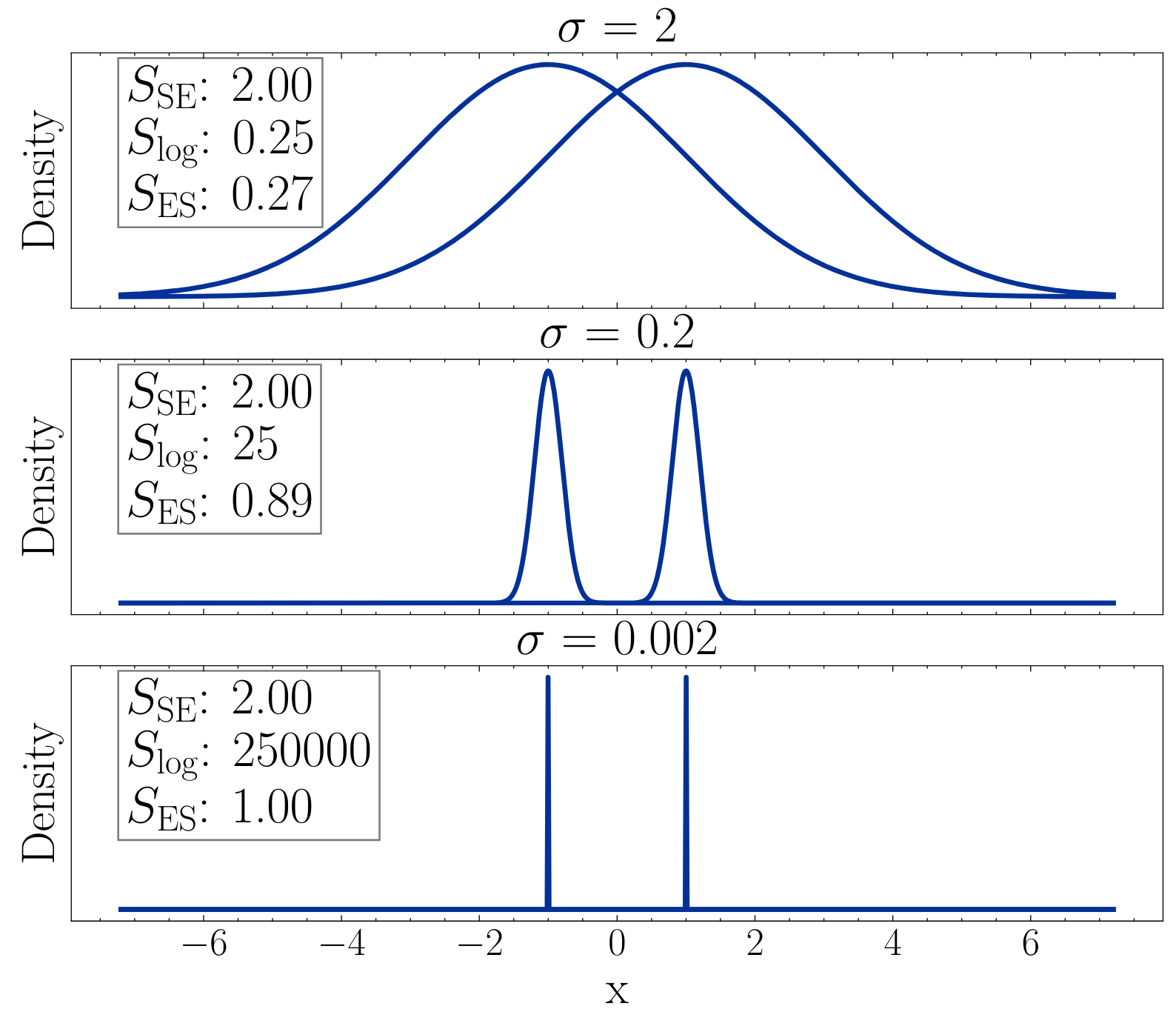 Uncertainty Quantification for Regression: A Unified Framework based on kernel scoresChristopher Bülte, Yusuf Sale, Gitta Kutyniok, and Eyke HüllermeierarXiv preprint arXiv:2510.25599, 2025
Uncertainty Quantification for Regression: A Unified Framework based on kernel scoresChristopher Bülte, Yusuf Sale, Gitta Kutyniok, and Eyke HüllermeierarXiv preprint arXiv:2510.25599, 2025Regression tasks, notably in safety-critical domains, require proper uncertainty quantification, yet the literature remains largely classification-focused. In this light, we introduce a family of measures for total, aleatoric, and epistemic uncertainty based on proper scoring rules, with a particular emphasis on kernel scores. The framework unifies several well-known measures and provides a principled recipe for designing new ones whose behavior, such as tail sensitivity, robustness, and out-of-distribution responsiveness, is governed by the choice of kernel. We prove explicit correspondences between kernel-score characteristics and downstream behavior, yielding concrete design guidelines for task-specific measures. Extensive experiments demonstrate that these measures are effective in downstream tasks and reveal clear trade-offs among instantiations, including robustness and out-of-distribution detection performance.
@article{bülte2025uncertaintyquantificationregressionunified, title = {Uncertainty Quantification for Regression: A Unified Framework based on kernel scores}, author = {Bülte, Christopher and Sale, Yusuf and Kutyniok, Gitta and Hüllermeier, Eyke}, journal = {arXiv preprint arXiv:2510.25599}, year = {2025}, eprint = {2510.25599}, archiveprefix = {arXiv}, primaryclass = {cs.LG}, url = {https://arxiv.org/abs/2510.25599}, } - arXiv
 Improved probabilistic regression using diffusion modelsCarlo Kneissl, Christopher Bülte, Philipp Scholl, and Gitta KutyniokarXiv preprint arXiv:2510.04583, 2025
Improved probabilistic regression using diffusion modelsCarlo Kneissl, Christopher Bülte, Philipp Scholl, and Gitta KutyniokarXiv preprint arXiv:2510.04583, 2025Probabilistic regression models the entire predictive distribution of a response variable, offering richer insights than classical point estimates and directly allowing for uncertainty quantification. While diffusion-based generative models have shown remarkable success in generating complex, high-dimensional data, their usage in general regression tasks often lacks uncertainty-related evaluation and remains limited to domain-specific applications. We propose a novel diffusion-based framework for probabilistic regression that learns predictive distributions in a nonparametric way. More specifically, we propose to model the full distribution of the diffusion noise, enabling adaptation to diverse tasks and enhanced uncertainty quantification. We investigate different noise parameterizations, analyze their trade-offs, and evaluate our framework across a broad range of regression tasks, covering low- and high-dimensional settings. For several experiments, our approach shows superior performance against existing baselines, while delivering calibrated uncertainty estimates, demonstrating its versatility as a tool for probabilistic prediction.
@article{kneissl2025improvedprobabilisticregressionusing, title = {Improved probabilistic regression using diffusion models}, author = {Kneissl, Carlo and Bülte, Christopher and Scholl, Philipp and Kutyniok, Gitta}, journal = {arXiv preprint arXiv:2510.04583}, year = {2025}, eprint = {2510.04583}, archiveprefix = {arXiv}, primaryclass = {cs.LG}, url = {https://arxiv.org/abs/2510.04583}, } - arXiv
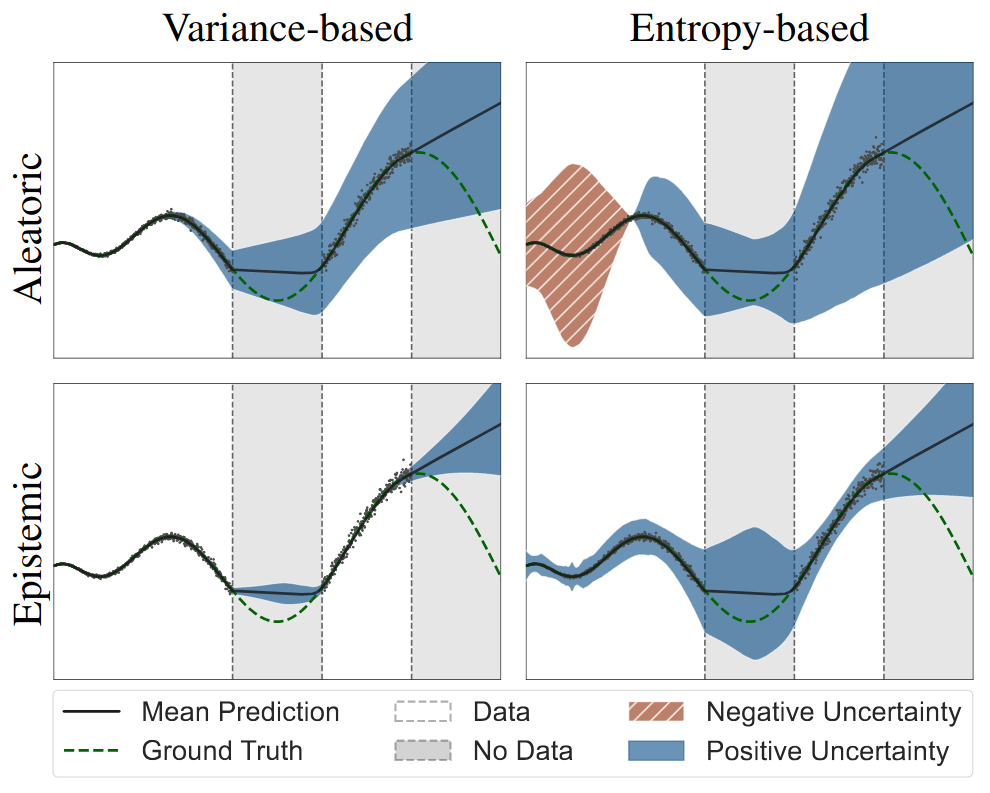 An Axiomatic Assessment of Entropy- and Variance-based Uncertainty Quantification in RegressionChristopher Bülte, Yusuf Sale, Timo Löhr, Paul Hofman, Gitta Kutyniok, and Eyke HüllermeierarXiv preprint arXiv:2504.18433, 2025
An Axiomatic Assessment of Entropy- and Variance-based Uncertainty Quantification in RegressionChristopher Bülte, Yusuf Sale, Timo Löhr, Paul Hofman, Gitta Kutyniok, and Eyke HüllermeierarXiv preprint arXiv:2504.18433, 2025Uncertainty quantification (UQ) is crucial in machine learning, yet most (axiomatic) studies of uncertainty measures focus on classification, leaving a gap in regression settings with limited formal justification and evaluations. In this work, we introduce a set of axioms to rigorously assess measures of aleatoric, epistemic, and total uncertainty in supervised regression. By utilizing a predictive exponential family, we can generalize commonly used approaches for uncertainty representation and corresponding uncertainty measures. More specifically, we analyze the widely used entropy- and variance-based measures regarding limitations and challenges. Our findings provide a principled foundation for UQ in regression, offering theoretical insights and practical guidelines for reliable uncertainty assessment.
@article{bulte_axiomatic, title = {An Axiomatic Assessment of Entropy- and Variance-based Uncertainty Quantification in Regression}, author = {Bülte, Christopher and Sale, Yusuf and Löhr, Timo and Hofman, Paul and Kutyniok, Gitta and Hüllermeier, Eyke}, journal = {arXiv preprint arXiv:2504.18433}, year = {2025}, eprint = {2504.18433}, archiveprefix = {arXiv}, primaryclass = {cs.LG}, url = {https://arxiv.org/abs/2504.18433}, } - ICLR 2025
 Graph Neural Networks for Enhancing Ensemble Forecasts of Extreme RainfallChristopher Bülte, Sohir Maskey, Philipp Scholl, Jonas Berg, and Gitta KutyniokICLR Workshop on Tackling Climate Change with Machine Learning, 2025
Graph Neural Networks for Enhancing Ensemble Forecasts of Extreme RainfallChristopher Bülte, Sohir Maskey, Philipp Scholl, Jonas Berg, and Gitta KutyniokICLR Workshop on Tackling Climate Change with Machine Learning, 2025Climate change is increasing the occurrence of extreme precipitation events, threatening infrastructure, agriculture, and public safety. Ensemble prediction systems provide probabilistic forecasts but exhibit biases and difficulties in capturing extreme weather. While post-processing techniques aim to enhance forecast accuracy, they rarely focus on precipitation, which exhibits complex spatial dependencies and tail behavior. Our novel framework leverages graph neural networks to post-process ensemble forecasts, specifically modeling the extremes of the underlying distribution. This allows to capture spatial dependencies and improves forecast accuracy for extreme events, thus leading to more reliable forecasts and mitigating risks of extreme precipitation and flooding.
@article{buelte_raincast, title = {Graph Neural Networks for Enhancing Ensemble Forecasts of Extreme Rainfall }, author = {Bülte, Christopher and Maskey, Sohir and Scholl, Philipp and von Berg, Jonas and Kutyniok, Gitta}, journal = {ICLR Workshop on Tackling Climate Change with Machine Learning}, year = {2025}, } - TMLR
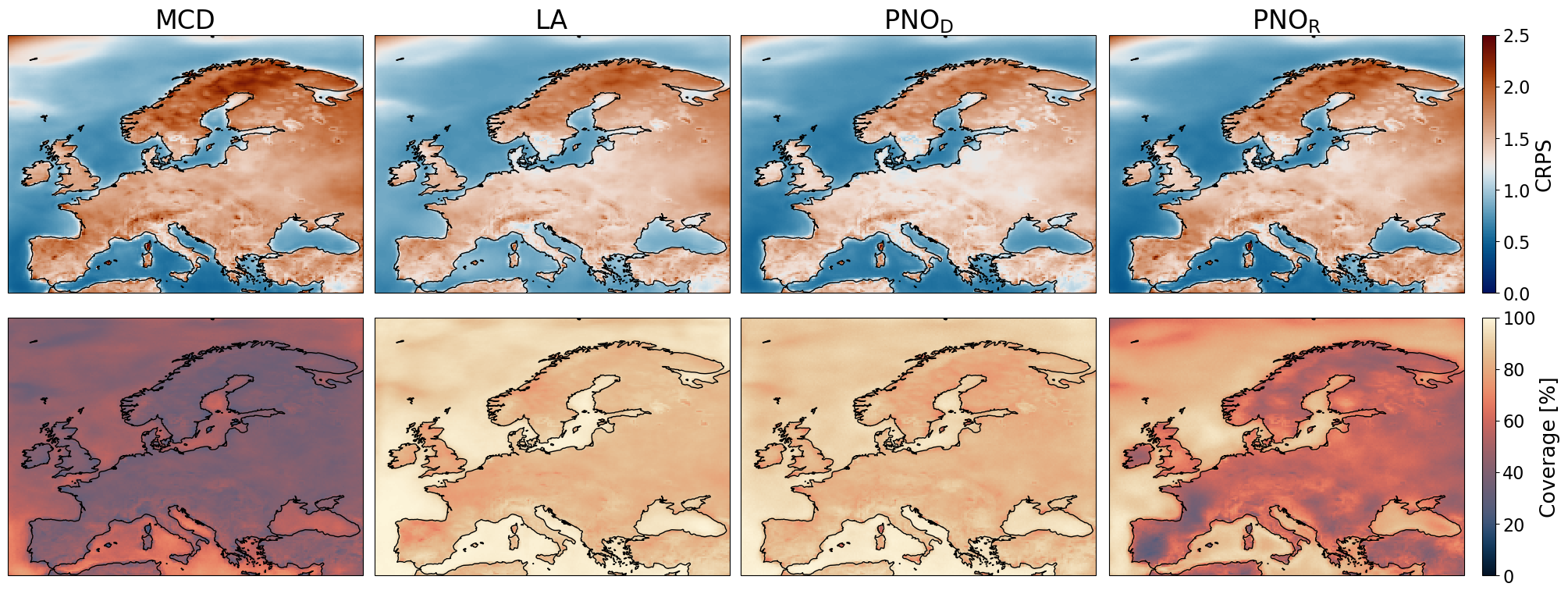 Probabilistic neural operators for functional uncertainty quantificationChristopher Bülte, Philipp Scholl, and Gitta KutyniokTransactions on Machine Learning Research, 2025
Probabilistic neural operators for functional uncertainty quantificationChristopher Bülte, Philipp Scholl, and Gitta KutyniokTransactions on Machine Learning Research, 2025Neural operators aim to approximate the solution operator of a system of differential equations purely from data. They have shown immense success in modeling complex dynamical systems across various domains. However, the occurrence of uncertainties inherent in both model and data has so far rarely been taken into account—a critical limitation in complex, chaotic systems such as weather forecasting. In this paper, we introduce the probabilistic neural operator (PNO), a framework for learning probability distributions over the output function space of neural operators. PNO extends neural operators with generative modeling based on strictly proper scoring rules, integrating uncertainty information directly into the training process. We provide a theoretical justification for the approach and demonstrate improved performance in quantifying uncertainty across different domains and with respect to different baselines. Furthermore, PNO requires minimal adjustment to existing architectures, shows improved performance for most probabilistic prediction tasks, and leads to well-calibrated predictive distributions and adequate uncertainty representations even for long dynamical trajectories. Implementing our approach into large-scale models for physical applications can lead to improvements in corresponding uncertainty quantification and extreme event identification, ultimately leading to a deeper understanding of the prediction of such surrogate models.
@article{bultepno, title = {Probabilistic neural operators for functional uncertainty quantification}, author = {B{\"u}lte, Christopher and Scholl, Philipp and Kutyniok, Gitta}, journal = {Transactions on Machine Learning Research}, issn = {2835-8856}, year = {2025}, url = {https://openreview.net/forum?id=gangoPXSRw}, note = {}, } - AIES
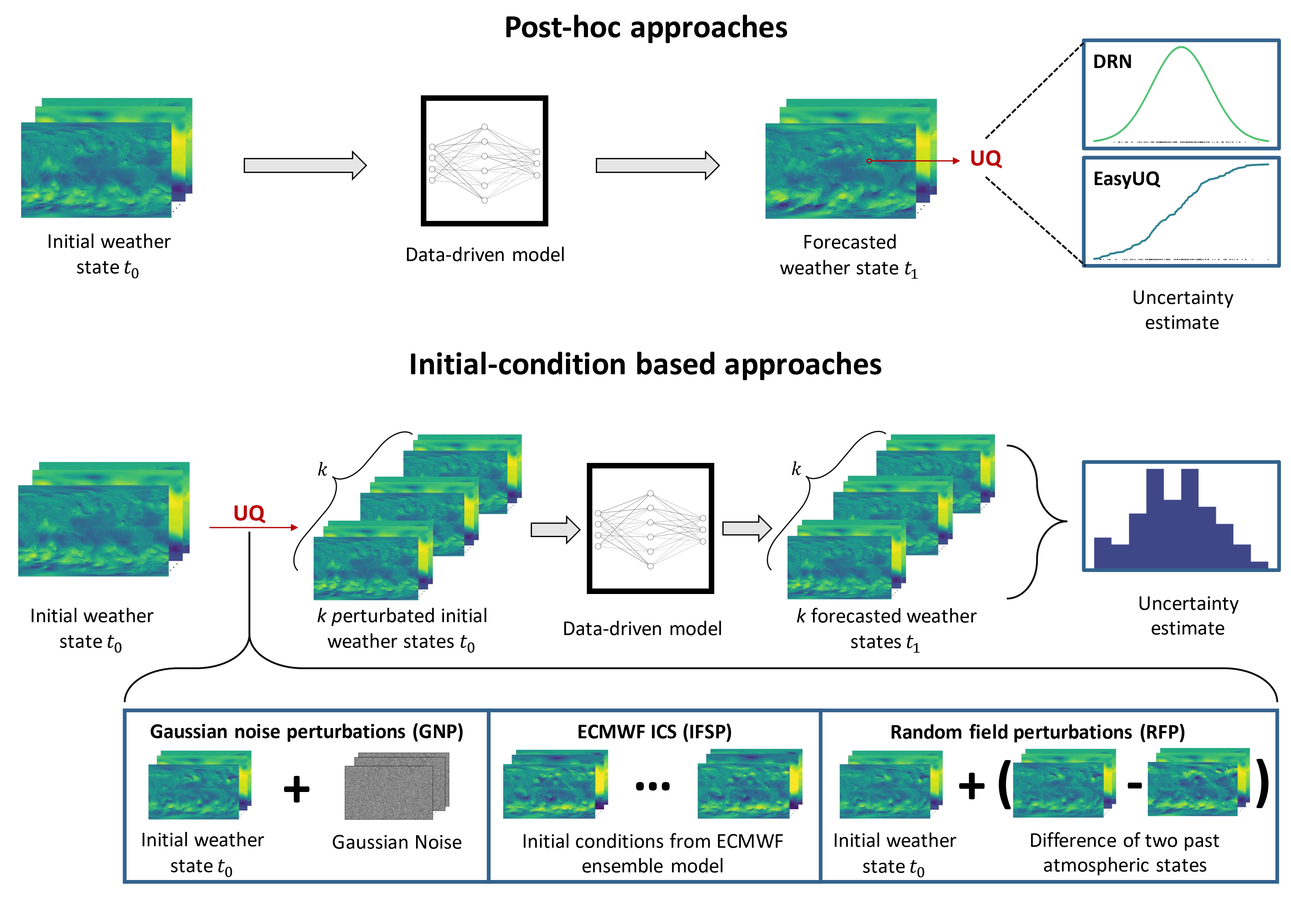 Uncertainty quantification for data-driven weather modelsChristopher Bülte, Nina Horat, Julian Quinting, and Sebastian LerchArtificial Intelligence for the Earth Systems, 2025
Uncertainty quantification for data-driven weather modelsChristopher Bülte, Nina Horat, Julian Quinting, and Sebastian LerchArtificial Intelligence for the Earth Systems, 2025Artificial intelligence (AI)-based data-driven weather forecasting models have experienced rapid progress over the last years. Recent studies, with models trained on reanalysis data, achieve impressive results and demonstrate substantial improvements over state-of-the-art physics-based numerical weather prediction models across a range of variables and evaluation metrics. Beyond improved predictions, the main advantages of data-driven weather models are their substantially lower computational costs and the faster generation of forecasts, once a model has been trained. However, most efforts in data-driven weather forecasting have been limited to deterministic, point-valued predictions, making it impossible to quantify forecast uncertainties, which is crucial in research and for optimal decision making in applications. Our overarching aim is to systematically study and compare uncertainty quantification methods to generate probabilistic weather forecasts from a state-of-the-art deterministic data-driven weather model, Pangu-Weather. Specifically, we compare approaches for quantifying forecast uncertainty based on generating ensemble forecasts via perturbations to the initial conditions, with the use of statistical and machine learning methods for post-hoc uncertainty quantification. In a case study on medium-range forecasts of selected weather variables over Europe, the probabilistic forecasts obtained by using the Pangu-Weather model in concert with uncertainty quantification methods show promising results and provide improvements over ensemble forecasts from the physics-based ensemble weather model of the European Centre for Medium-Range Weather Forecasts for lead times of up to 5 days.
@article{bulteUncertaintyQuantificationDatadriven2024, title = {Uncertainty quantification for data-driven weather models}, author = {Bülte, Christopher and Horat, Nina and Quinting, Julian and Lerch, Sebastian}, journal = {Artificial Intelligence for the Earth Systems}, year = {2025}, doi = {10.1175/AIES-D-24-0049.1}, url = {https://journals.ametsoc.org/view/journals/aies/aop/AIES-D-24-0049.1/AIES-D-24-0049.1.xml}, }
2024
2024
- NeurIPS 2024
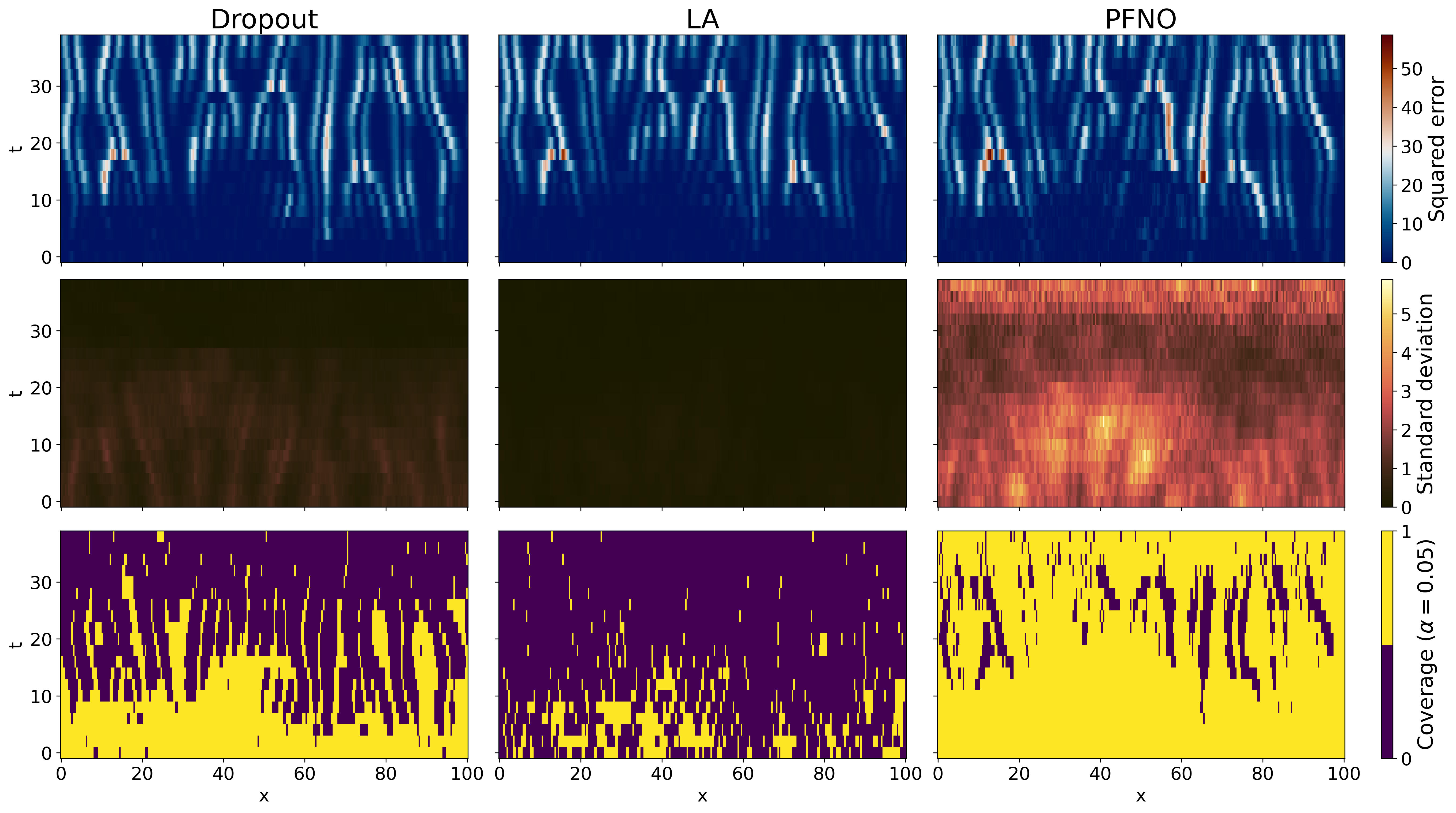 Probabilistic predictions with Fourier neural operatorsChristopher Bülte, Philipp Scholl, and Gitta KutyniokNeurIPS 2024 workshop on Bayesian Decision-making and Uncertainty, 2024
Probabilistic predictions with Fourier neural operatorsChristopher Bülte, Philipp Scholl, and Gitta KutyniokNeurIPS 2024 workshop on Bayesian Decision-making and Uncertainty, 2024Neural networks have been successfully applied in modeling partial differential equations, especially in dynamical systems. Commonly used models, such as neural operators, are performing well at deterministic prediction tasks, but lack a quantification of the uncertainty inherent in many complex systems, for example weather forecasting. In this paper, we explore a new approach that combines Fourier neural operators with generative modeling based on strictly proper scoring rules in order to create well-calibrated probabilistic predictions of dynamical systems. We demonstrate improved predictive uncertainty for our approach, especially in settings with very high inherent uncertainty.
@article{prob_predictions_neural_operator, title = {Probabilistic predictions with Fourier neural operators}, author = {Bülte, Christopher and Scholl, Philipp and Kutyniok, Gitta}, journal = {NeurIPS 2024 workshop on Bayesian Decision-making and Uncertainty}, url = {https://openreview.net/forum?id=orKA6gJwlB}, year = {2024}, } - arXiv
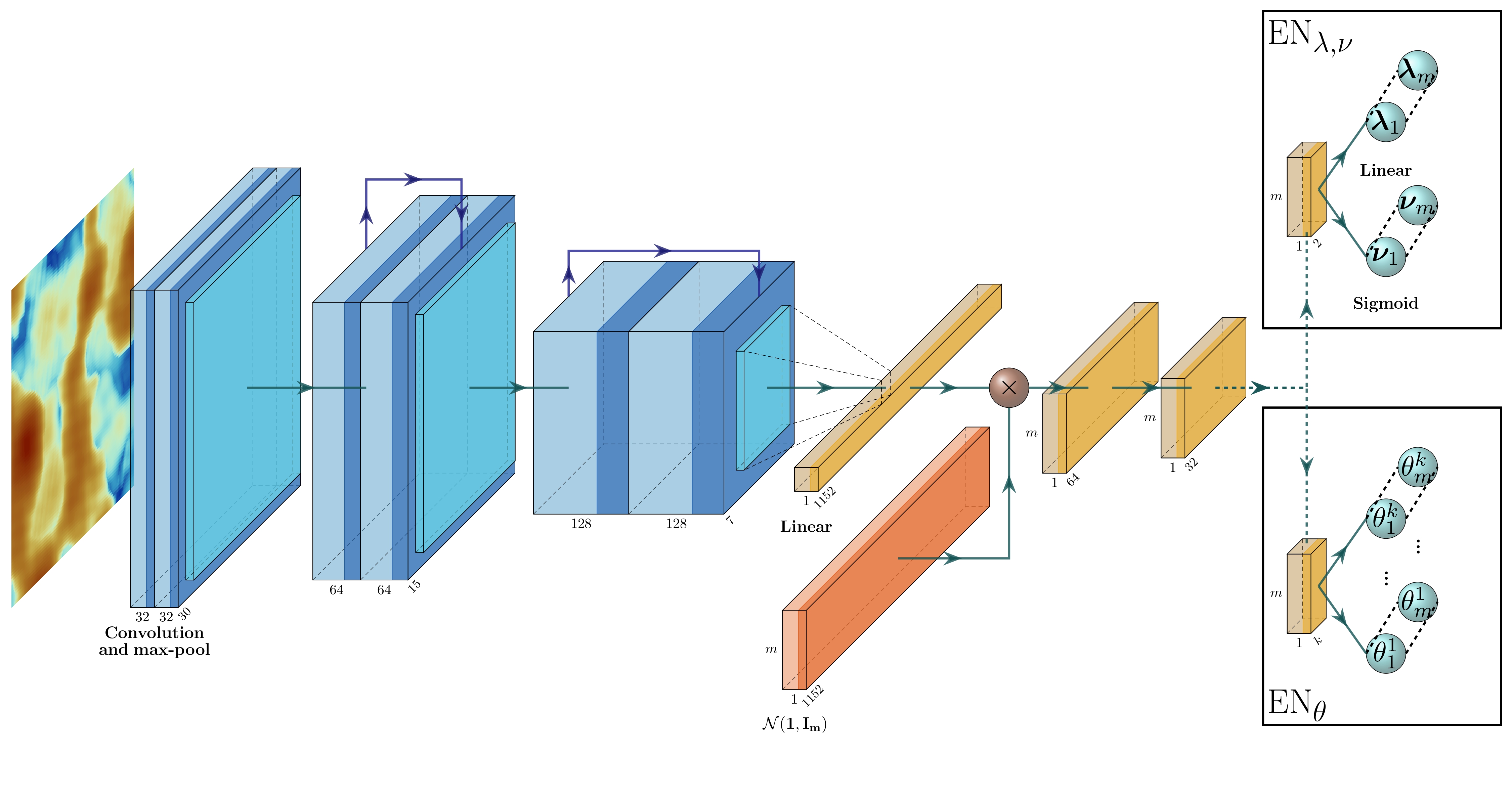 Modeling Spatial Extremal Dependence of Precipitation Using Distributional Neural NetworksChristopher Bülte, Lisa Leimenstoll, and Melanie SchienlearXiv preprint arXiv:2407.08668, 2024
Modeling Spatial Extremal Dependence of Precipitation Using Distributional Neural NetworksChristopher Bülte, Lisa Leimenstoll, and Melanie SchienlearXiv preprint arXiv:2407.08668, 2024In this work, we propose a simulation-based estimation approach using generative neural networks to determine dependencies of precipitation maxima and their underlying uncertainty in time and space. Within the common framework of max-stable processes for extremes under temporal and spatial dependence, our methodology allows estimating the process parameters and their respective uncertainty, but also delivers an explicit nonparametric estimate of the spatial dependence through the pairwise extremal coefficient function. We illustrate the effectiveness and robustness of our approach in a thorough finite sample study where we obtain good performance in complex settings for which closed-form likelihood estimation becomes intractable. We use the technique for studying monthly rainfall maxima in Western Germany for the period 2021-2023, which is of particular interest since it contains an extreme precipitation and consecutive flooding event in July 2021 that had a massive deadly impact. Beyond the considered setting, the presented methodology and its main generative ideas also have great potential for other applications.
@article{bulteEstimationSpatiotemporalExtremes2024, title = {Modeling Spatial Extremal Dependence of Precipitation Using Distributional Neural Networks}, author = {Bülte, Christopher and Leimenstoll, Lisa and Schienle, Melanie}, journal = {arXiv preprint arXiv:2407.08668}, year = {2024}, eprint = {2407.08668}, eprinttype = {arXiv}, eprintclass = {cs, stat}, url = {http://arxiv.org/abs/2407.08668}, urldate = {2024-07-13}, keywords = {Computer Science - Machine Learning,Statistics - Machine Learning}, }
2023
2023
- Energy & AI
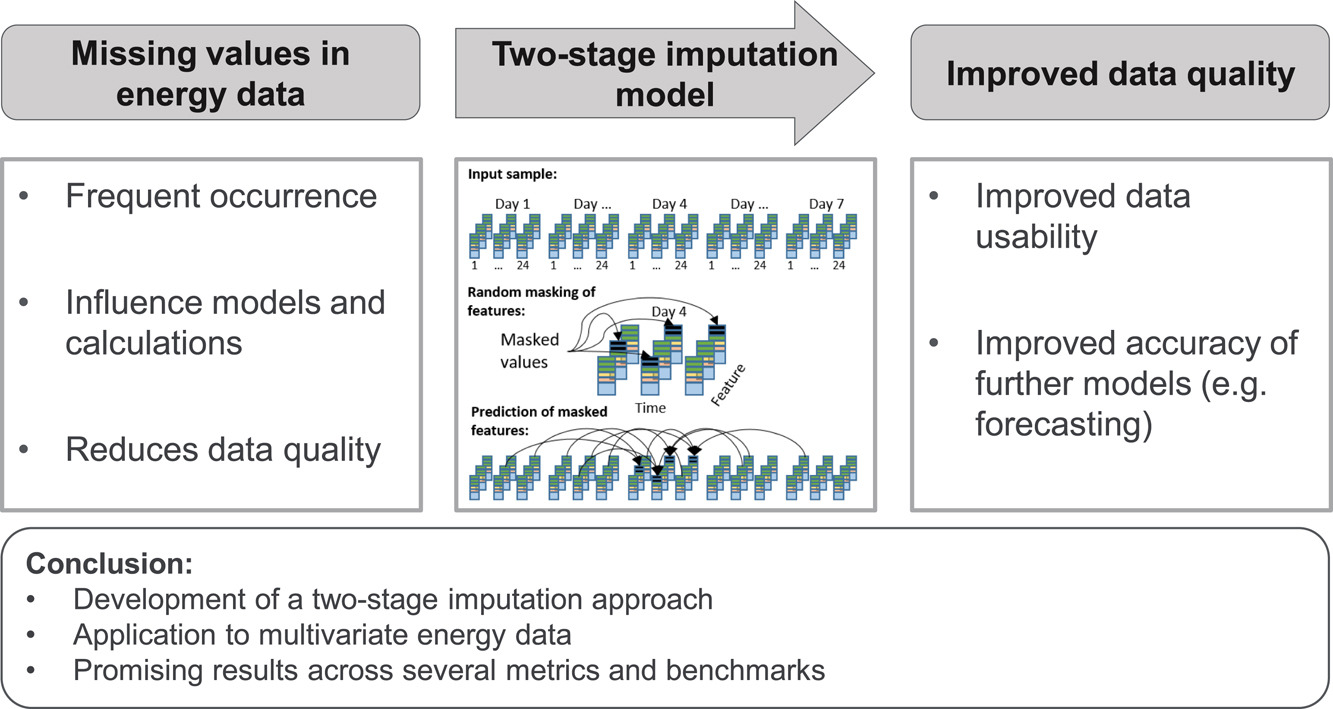 Multivariate Time Series Imputation for Energy Data Using Neural NetworksChristopher Bülte, Max Kleinebrahm, Hasan Ümitcan Yilmaz, and Juan Gómez-RomeroEnergy and AI, 2023
Multivariate Time Series Imputation for Energy Data Using Neural NetworksChristopher Bülte, Max Kleinebrahm, Hasan Ümitcan Yilmaz, and Juan Gómez-RomeroEnergy and AI, 2023Multivariate time series with missing values are common in a wide range of applications, including energy data. Existing imputation methods often fail to focus on the temporal dynamics and the cross-dimensional correlation simultaneously. In this paper we propose a two-step method based on an attention model to impute missing values in multivariate energy time series. First, the underlying distribution of the missing values in the data is learned. This information is then further used to train an attention based imputation model. By learning the distribution prior to the imputation process, the model can respond flexibly to the specific characteristics of the underlying data. The developed model is applied to European energy data, obtained from the European Network of Transmission System Operators for Electricity. Using different evaluation metrics and benchmarks, the conducted experiments show that the proposed model is preferable to the benchmarks and is able to accurately impute missing values.
@article{bulteMultivariateTimeSeries2023, title = {Multivariate Time Series Imputation for Energy Data Using Neural Networks}, author = {Bülte, Christopher and Kleinebrahm, Max and Yilmaz, Hasan Ümitcan and Gómez-Romero, Juan}, year = {2023}, journal = {Energy and AI}, volume = {13}, pages = {100239}, issn = {2666-5468}, doi = {10.1016/j.egyai.2023.100239}, url = {https://www.sciencedirect.com/science/article/pii/S2666546823000113}, keywords = {Attention model, Energy data, Missing value estimation, Multivariate time series, Neural networks}, }